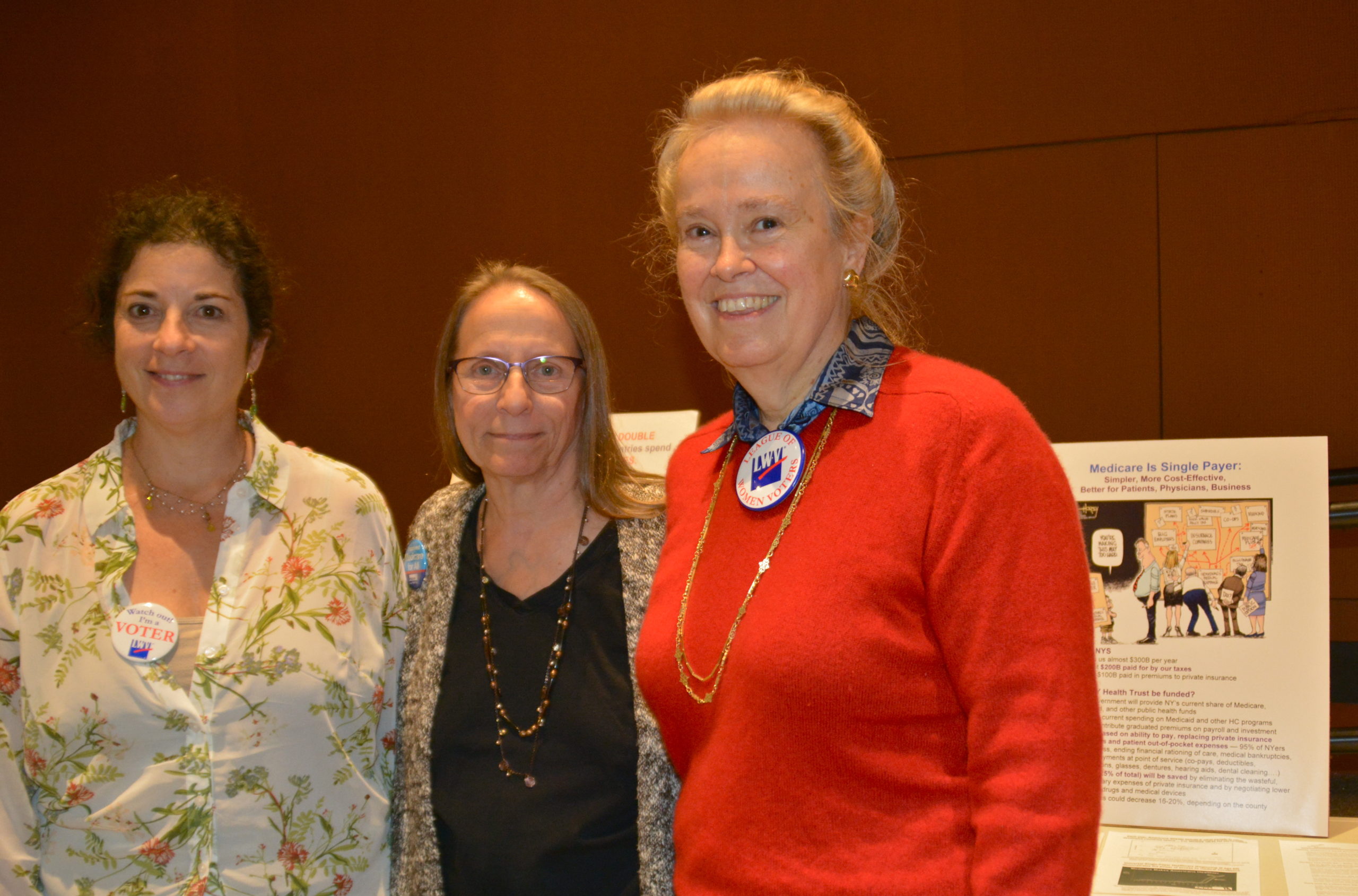By Pat Grace
The New York Health Act: Improved Medicare for All New Yorkers is surprisingly close to bringing universal, comprehensive and cost-effective healthcare to New York State. At the League of Women Voters of Port Washington-Manhasset Nov. 2 event at the Port Washington Library, the featured speaker, Prof. Martha Livingston, Chair of the Dept. of Public Health at SUNY College at Old Westbury, explained that 23 states now have similar legislation pending.
In January 2017, Livingston explained, New York was 10 senators short of approving the plan. Today, the senate vote is even; only one senator more has to approve. Bills in New York and California are the closest to being enacted, Livingston said, perhaps as early as spring 2018. And a month ago Governor Cuomo voiced his support.
When League of Women Voters of Port Washington-Manhasset President Julie Meer Harnick introduced Dr. Judith Esterquest, Health Issues Chair of LWVPWM, and member LWV-NYS Health Issues Committee, at the Nov. 2 event at the Port Washington Public Library, Harnick praised Esterquest for spearheading the event and emphasized the league’s ability to adapt to members’ interests and convictions. The league is non-partisan and a stated goal is to promote political responsibility through informed and active participation of citizens in government.

To that end, the evening began with the screening of “Fix It: Healthcare at the Tipping Point,” a short film followed by a Q&A with Prof. Martha Livingston.
View the film at fixithealthcare.com, produced in 2016 by Richard Master, founder and owner of MSC Industries.
According to the individuals quoted in the film, uncontrolled healthcare costs are a factor in the huge federal deficit, where taxes currently pay about two-thirds of all American healthcare costs in a system where Americans spend twice as much per capita as other developed countries; surprisingly, these wealthy countries that spend so much less per capita also provide universal healthcare.
About 60 percent of personal bankruptcies in America are caused by medical expenses, and most of those declaring bankruptcy have health insurance. The film pointed out that all but the wealthiest Americans are one diagnosis away from financial disaster — unlike countries with universal healthcare.
Livingston also noted that the NY Health Act would cut New York’s current expenditures on healthcare by about 25 percent before adding some costs like increasing reimbursements to physicians who treat the poor. Combining federal healthcare funding, current state funding, and the estimated $45 billion in savings, the NY Health Act could provide all NY residents with comprehensive healthcare, she said, for far less than is currently spent.
Livingston noted that about 50 percent of our property taxes currently pay for healthcare, and the NY Health Act would likely save between 16 percent and 20 percent of local budgets because of a decrease in healthcare costs.
Business owners’ profits are eroded by relentless increases in healthcare costs and, according to the film, most agree that insurance company middlemen add little value. Richard Master of MSC Industries explains on camera that 30 percent of every healthcare dollar is spent on non-health related activities: profits and administration for insurance middlemen and the administrative complexity they spawn.
He argues that single-payer alternatives, like Traditional Medicare in the U.S. and like Medicare in Canada, which provides healthcare for every Canadian, eliminate the costly complexity of the multi-payer system and have a long track record of controlling costs better. They also allow physicians to focus on patients (not arguing about benefits with insurers). Numerous business owners and economists in the film explain that the multi-payer system adds a significant burden to American businesses.
To meet Wall Street expectations, the film stated, insurance companies discourage care. The movie compared yearly doctor visits in Japan (13) with the United States (4.2) where the system is set up to discourage seeing doctors. France is first in providing healthcare, Australia is second, and America is 19th with its citizens more likely to defer medical care.
“Sick Around the World,” a PBS special that can be viewed online, was recommended by Livingston. Insurance companies, according to the movie, add more cost than value.
According to the movie and Livingston, traditional Medicare is the most trusted healthcare in the U.S., has the lowest overhead costs (2 percent versus 15 to 20 percent of for-profit insurance), despite covering the oldest and sickest citizens. Traditional Medicare, where the government pays the bills but doesn’t choose your doctor or hospital, does not pay its executives $10 million salaries, requires far less paperwork for health providers and far fewer hours of interface.
“Warts and all,” Livingston said, “single-payer insurance is one of the most popular programs in the country.”
The movie asks, “Can we afford single payer?” It answers, “We can’t afford the current system.”
An animated Q&A followed the film. Audience members asked how it would be paid for. Livingston answered one way was graduated taxes, the more you make, the more you pay. She added that 98 percent of New Yorkers would be paying less than they currently do for healthcare premiums and out-of-pocket costs.
Livingston encouraged individuals to visit NYHCampaign.org for more comprehensive information, including a “calculator” using your income and current insurance to see an estimate of how much you will save for comprehensive healthcare, including all doctor visits, hospitalization, prescription drugs and more, with no payment due at point of service.
Another question was why we don’t have single payer insurance already. The answer: big insurance and big pharmaceutical companies employ two lobbyists for every member of Congress. They are also among the most profitable of all American industries and among the biggest campaign donors. Another question, if the New York Health Act passes, what happens if you go to Florida for the winter.
The answer: you are still covered by New York.
Livingston recalled how, during the 2017 spring recess, as the Trump Administration battled to repeal and replace the Affordable Care Act, some citizens became actively involved to dissuade their representatives. If you believe the New York Health Act is a good idea for New York, contact your senators now, directed Livingston. An audience member added, “When the people lead, the leaders will follow.”
Judy Esterquest contributed to this article.



